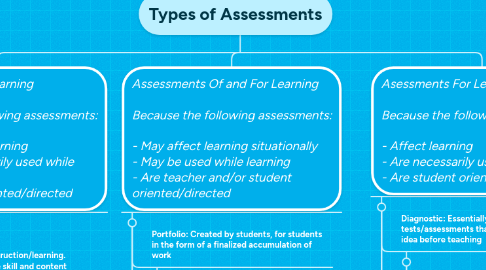
1. Asessments Of Learning Because the following assessments: - Do not affect learning - Are not necessarily used while learning - Are teacher oriented/directed
1.1. Summative: Takes place after instruction/learning. Attempts to measure skill and content mastery.
1.1.1. Advantages: Paints general picture of student accomplisment related to a topic/standard
1.1.2. Disadvantages: Impersonal and inaccurate
1.1.3. High School Example: Chapter/Unit exams
1.2. High Stakes: Standardized and generalized tests used to determine overall teacher and student effectiveness.
1.2.1. Advantages: Useful for admittance to college/other schools
1.2.2. Disadvantages: Overgeneralization; "Student-as-a-number"
1.2.3. High School Example: NWEA, SAT
2. Asessments For Learning Because the following assessments: - Affect learning - Are necessarily used while learning - Are student oriented/directed
2.1. Diagnostic: Essentially pre tests/assessments that give teachers an idea before teaching
2.1.1. Advantages: Specific to student; provides baseline of prior content mastery
2.1.2. Disadvantages: Only good for assessing general areas (i.e. math, reading comprehension, writing, etc.)
2.1.3. High School Example: Pre-Unit Test
2.2. Formative: Happens during every lesson and is used to make real time changes in instruction
2.2.1. Advantages: Useful in editing plans
2.2.2. Disadvantages: Difficult to find the right balance; too much data/information
2.2.3. High School Example: Exit slips, observation, and many others
2.3. Peer: Comparative method allowing students to determine positive/negative qualities about the work of their classmates
2.3.1. Advantages: Collaborative; teaches constructive criticism as a positive tool
2.3.2. Disadvantages: Generally subjective if not expertly introduced, delivered, and observed.
2.3.3. High School Example:Peer review of online post/reposnse
2.4. Self: Allowing students to evaluate their own work and progress, given guidelines
2.4.1. Advantages: Encourages self-reflection
2.4.2. Disadvantages: Can become severly biased, esp. based on maturity level
2.4.3. High School Example: Self-reflection on in-class presentation
3. Assessments Of and For Learning Because the following assessments: - May affect learning situationally - May be used while learning - Are teacher and/or student oriented/directed
3.1. Portfolio: Created by students, for students in the form of a finalized accumulation of work
3.1.1. Advantages: Student-created, personalized
3.1.2. Disadvantages: So personalized that it makes drawing objective conclusions difficult
3.1.3. High School Example: Collected writings of a student over the course of a unit/quarter/semester
3.2. Performance-Based: Student-involved, active demonstration of knowledge/content and skills.
3.2.1. Advantages: Student involvement
3.2.2. Disadvantages: May be difficult to match up with appropriate curricular standards
3.2.3. High School Example: Team debates
3.3. Authentic: Derived from real world situations and focused on analysis
3.3.1. Advantages: Has value in the real world later on
3.3.2. Disadvantages: Difficult to standardize/stay objective
3.3.3. High School Example: Measuring surface area and volume of large, real world objects in geometry [I actually did this as a unit last year]

